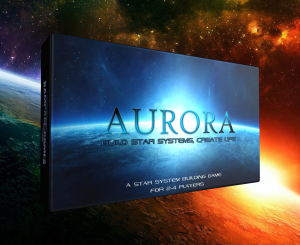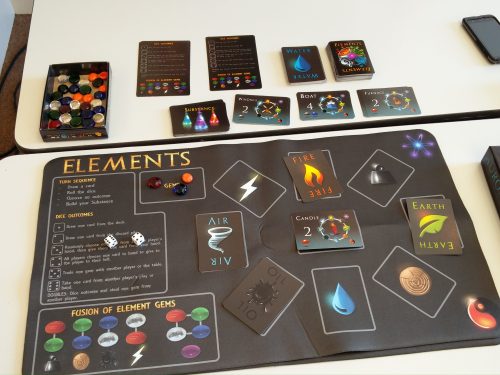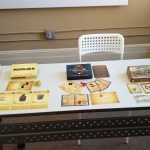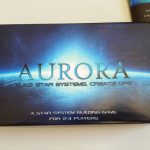 “Who are we? Where are We from?”
“Who are we? Where are We from?”
I first saw Aurora at CT FIG 2016 while playing Elements at the Rampage Games booth. Not having time to play that day, Rampage sent me a copy of my own to checkout. I finally had a chance to sit down and play with my kids, and was surprised what a competent little set collection game it is.
Aurora is a game about creating star systems that can support sentient life. It was a submission to The Game Crafter’s Learning Game Challenge, and made it to the finals.
Each round you’re creating or expanding star systems trying to meet all the requirements for intelligence. Every card in your star system also provides a certain amount of either Water, Carbon, or Oxygen. Building your levels of these resources earn you bonuses throughout the game. There’s also event cards that can be played to help yourself or hinder other players. Once a round is over you can save up to three cards, pass the rest to the player on the left, then draw up to 6 cards for a max hand size of 8. Play continues until either one person develops intelligence, has life in three star systems, or maxes out their resource tracks. It plays in about 30 minutes, and the kids and I had a blast while playing.
 There are a few pitfalls, though. The rules aren’t as clear as they could be, and make the game seem a bit more complicated than it really is. Also, the colors on some of the components, especially the reference guide and rule book, blend a bit and make the text hard to read in some areas. Overall these aren’t really deal breakers, but are items that can be fixed to make Aurora a much more solid package.
There are a few pitfalls, though. The rules aren’t as clear as they could be, and make the game seem a bit more complicated than it really is. Also, the colors on some of the components, especially the reference guide and rule book, blend a bit and make the text hard to read in some areas. Overall these aren’t really deal breakers, but are items that can be fixed to make Aurora a much more solid package.
Aurora packs a lot of game into a deck of cards. Between the multiple paths to victory and drafting mechanics, it provides a good amount of depth is a short period of time. It’s also easy enough to play with kids. My 6-year-old was able to grasp the game well enough to play on his own after a few rounds, and my 9-year-old pulled out a surprise victory by developing intelligence on our first play of the game.
A copy of Aurora was provided free for review by Rampage Games.
- Comments Off on Second Look—Aurora
 Rampage Games was one of the first booths I sat down at during CT FIG, and their game Elements was my first play of the day. I actually sat down to play while they were counting down the end of their successful Kickstarter campaign, so this is a game we’ll hopefully be seeing available to sale soon.
Rampage Games was one of the first booths I sat down at during CT FIG, and their game Elements was my first play of the day. I actually sat down to play while they were counting down the end of their successful Kickstarter campaign, so this is a game we’ll hopefully be seeing available to sale soon.
Elements is a card game where you’re trying to use base elements to create an object. Each object is worth points, and the more complicated it is to make, the more points it’s worth.
Each turn a player will draw a card, roll the dice, choose one of the actions available based on their rolls, and work on laying cards down to build their item. There’s also gems that can be earned that will count as an element, can be combined to become a more complex element, or even give bonuses to completed items.
Elements was really quick to learn, fairly light, and very entertaining. It’s minimal design works well, and there’s plenty of opportunities to mess with other players, so it never feels like you’re playing a game of solitaire while racing to see who wins first. It’s a game I’ll be adding to my shelf, as I think it’s one I could get a lot of play in with the kids.
Rampage was also showing off a bunch of their Game Crafter produced games: Aurora, Iron Horses, Woodland, and Adrift. I didn’t get a chance to play any, but got the rundown on each of the four. Out of all of them, Aurora really caught my eye. It’s a game about building a star system to support intelligent life. I’ll have that one in for review soon, so I’ll see if lives up to my expectations!
- Comments Off on CT FIG – Elements by Rampage Games
Trending
- Massdrop.com
- Oh the Irony—Illuminati Card Game Continues to Inspire Conspiracy Theorists
- Home
- Footprints, an Educational Ecology Game
- USPS Adds Board Game Flat Rate Box
- Baila, the Estonian Drinking Card Game
- Crystal Caste Wins Dice Patent Suit Against Hasbro
- Mirror Game, Red and Blue
- Hasbro and Mattel Merger?
- Are Board Games Dangerous?
Archives
Most Popular Articles
- Oh the Irony—Illuminati Card Game Continues to Inspire Conspiracy Theorists
- The 20 Most Valuable Vintage Board Games
- The Truth About Dominoes On Sunday in Alabama
- Sequence Game, and Variants
- USPS Adds Board Game Flat Rate Box
- Baila, the Estonian Drinking Card Game
- The 13 Most Popular Dice Games
- Are Board Games Dangerous?
- Guess Who? The Naked Version
- What Happened to the Jewel Royale Chess Set?
Recent Posts
- Toy Fair 2019—Breaking Games
- Talisman Kingdom Hearts Edition
- Toy Fair 2019—Winning Moves
- Toy Fair 2019—Games Workshop
- Toy Fair 2019—Star Wars Lightsaber Academy
- Toy Fair 2019—Stranger Things Games
- Toy Fair 2019—HABA
- Licensing Roundup
- Game Bandit
- 2018 A Difficult Year For Hasbro But Not For D&D Or MtG
Recent Comments
- on Toy Fair 2019—Winning Moves
- on Game Bandit
- on Second Look—Dungeons & Dragons Waterdeep Dragon Heist
- on Crowdfunding Highlights
- on Beyblade SlingShock
- on Game Bandit
- on Game Bandit
- on Watch This Game!, the Board Game Review Board Game
- on Second Look—Vampire: The Masquerade 5th Edition
- on Palladium Books Loses Robotech IP License, Cancels Five-Year-Overdue Robotech RPG Tactics Kickstarter






